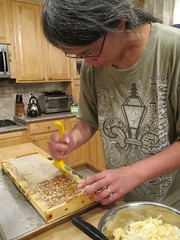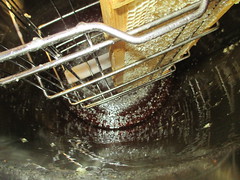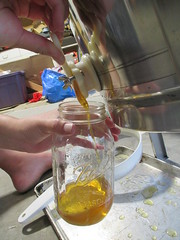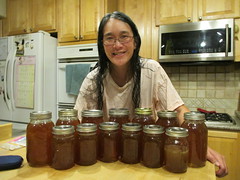The previous Wednesday I went to a little spin-in with four ladies and we dyed wool from the setup that the lady there had. But one of the other ladies was thinking about keeping bees as she’d inherited a top bar hive from a family that had simply neglected it, thinking that it was kinder to not bother the bees.
The bees had filled the hive, getting past a stopper that was supposed to keep them from the rest of the hive, and building on all the bars past that. And when they’d run out of space, they’d left. So I really wanted to make sure that my colony had plenty of space to build and store honey.
On Friday, I went into the hive to look. I wasn't at all sure what I was going to find, but figured it was better to know than to guess and not know. John did a lot of work helping get my smoker going, and I suited up, had all my equipment, and found that I actually didn’t have any extra medium frames. So if I wanted to replace frames, I really couldn’t. Instead, I’d just have to take them out, do what I needed to do to them, and then put them back in, if I was going to do that. The hive still has the rest of August and September to fill in their stores for the winter. So I had to figure out what it was I needed to take out, but also what I needed to leave so that they would still have enough room for what was to come.
They were pretty easygoing about me going into the top of the hive. I wasn't bothering the brood boxes at all, and while there were a large number of bees on the inside of the cover and a lot of bees on the frames up there, they all moved pretty quickly once I had smoke on them.
I managed to pull four completely full, capped frames from the center of the top super, and found that the other four were mostly filled, but not capped. The outside most frames weren't completely drawn out, yet. So I left them, in the center of the box while I took the four full frames inside.
We tried to uncap them and see if any honey would flow out without spinning them, but nothing at all came out, the surface tension was so high. So John and I had a discussion, and we went to Murdock's and bought an extractor. It was for a couple of hundred dollars, but it was stainless steel, solidly built, and was kind of made to last throughout the years. So we now have an extractor, and talking it over, I went back into the hive and got the central four frames from the lower super as well, and moved the four partially filled frames into the lower super to go with the four that were also not completely full in there that were already there.
I pulled the top super completely, and put the lid onto the hive. And we had eight completely full frames to process. Four of the eight frames that stayed in the hive were at least half full. So there was a lot of honey in the hive, still, that I'll probably just leave for the girls in the long run. I'd rather they had supplies into the fall and winter.
Uncapping the honey was an interesting process. We started by trying it with hot knives, that kind of did the job? But sometimes I dug a little too deep or destroyed the comb in ways that I really didn't like. So we got a scratcher, and I managed to just pick off the very top of the caps. I put most of the wax into a bowl that I've since melted. The wax floats to the top and the honey sinks to the bottom, and it's a clean way to extract both.
It did a really good job of it for just five dollars, so I was really happy with it.
Once the caps were off, the frames could go into the extractor, and then the cage would just spin around and around, flinging the honey against the side of the cannister. It would then flow to the bottom of the collector. A little of the wax was still in the honey at that point.
But it was amazing to put the heavy, full frames into the cage, start doing the hand cranking and suddenly it would lighten immensely, as the force on the honey itself made it so that it would flow from the cells. The main reason to do it this way, too, is something Ken Adelman pointed out to me, which was that the wax takes about seven times the honey to make for the bees. It's such an energy intensive substance, that if the bees don't have to make it again, they can collect a lot more honey.
This was the first process that helped get the honey away from the caps. When the honey was deep over the valve, the wax would float to the top, and not come out the bottom here. So quite a few of the jars that I filled were clear of wax simply because it wasn't flowing out with the honey.
It was amazing to watch this happen, actually, given that the last time I had a hive, we'd actually just scraped all the honeycomb off the base plastic onto sheet pans, and then poured the whole mass into a sieve and pressed on it to get as much honey out of the wax as possible. It meant that we took all the wax... and had to deal with all the wax. This way we only had to deal with the caps that we'd scraped off and the ones that we'd missed and left on the comb before spinning it.
For the last few quarts, we just poured all the honey through a sieve into a bowl and let it flow through in the summer heat of our closed garage. The heat let it flow really well, and the caps all stayed in the sieve. Little bits of wax still got into the bottles, but it's one way to know that it's real, raw honey, I think.
I ended up with a bit more than two and a half gallons of honey, and when I melted all the resultant caps, I had another pint, nearly, of heat-treated honey that I'm keeping for my hot milk and Jet's tea. *laughs* It's good.
A mug of warm milk with a single spoonful of honey is now my favorite comfort food, and it's been really nice with the weather these last two weeks. It's been uncommonly rainy and cloudy for this area, and much cooler than Augusts usually are for this region.
So we've been having hot tea and warm milk in the evenings. When we'd pulled all the frames from the extractor, I put them all back into the super and put the whole thing back on top of the hive. It gives them already waxed frames for them to put things into for the last part of this month, the next, and into October, as the flowers go strong until the first frost, which usually isn't until late September or into October.
But it feels so cold, already, I may well just take the second super off and have the ladies fill the brood boxes and the single super so that they're simply ready for fall and winter earlier than not.
It's all something of a guess. It's odd to realize that, but the main principle is that they should have enough honey in the brood boxes to winter over with, and I really don't want to take much more honey this year, as two and a half gallons is a LOT of honey. I was even wondering if I should be putting some of it back into a feeder so that they could just put it back into their comb.
Which seems so odd compared to my initial fear of them not having enough room or enough work to do, so that they'd leave... so maybe I just have to trust my judgment, and let them do their work for the rest of the summer. Peaches and sweet corn are coming in, along with the New Mexican chilies and other things as well. So it's going to be interesting to see how it all works.
One nice thing is that a lot of the neighbors want honey, and are willing to pay me for it, and given the unexpected expense of the extractor and the price of the original three pounds of workers and the queen, it'll be good to get the money for the girls' work.




No comments:
Post a Comment